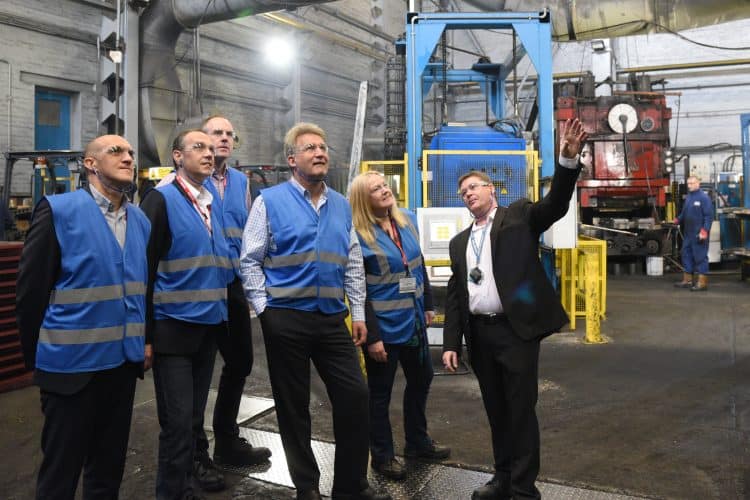The first of a series of Wi-Fi 6 trials for industrial enterprise and the internet of things (IoT) is underway in the UK.
The Wireless Broadband Alliance, an organization that supports the adoption of next generation Wi-Fi services across the Wi-Fi ecosystem, said that it will be testing several use cases on a Wi-Fi 6 network at Mettis Aerospace’s 27-acre facility in West Midlands starting in the second half of 2019.
Use cases under consideration include multi-stream live video monitoring, real time energy monitoring, ultra-reliable low latency communications with sensors on critical systems, and augmented reality.
UK-based Mettis Aerospace designs and manufactures precision-forged, machine and sub-assembled components, primarily for the aerospace and defense industry. Its clients include Airbus, Boeing, and Rolls-Royce.
WBA said the West Midlands region was selected as the UK’s 5G Testbed for manufacturing and security by the UK Government’s Department for Digital, Culture, Media & Sport.
The trials, managed by the WBA and Mettis Aerospace, and supported by WBA members including British Telecom, Boingo, Broadcom, BSG Wireless, CableLabs, Cisco, HPE Aruba and Intel, will demonstrate the role of Wi-Fi 6 in the broader 5G ecosystem and will serve as an example to industrial manufacturers moving to industry 4.0.
“Wi-Fi 6 is a critical component for the future of connectivity for enterprises, operators, and consumers," said Tiago Rodrigues, General Manager, WBA.
Mark Stansfield, Chair of the Worcestershire Local Enterprise Partnership, affirmed that 5G and Wi-Fi 6 are complementary technologies and the first live 5G factory trials is an important step in the evolution of smart factories.
Next-generation wireless
The UK trial is part of WBA's Wi-Fi 6 program, which seeks to fasttrack the new Wi-Fi 6 standard — 802.11ax — for operators. Among its long-term targets is to establish Wi-Fi 6 deployment guidelines as the new industry standard, and enable equipment providers to bring their Wi-Fi 6-ready equipment.
Hence, the organization is seeking to provide a platform for Wi-Fi 6 trials and testing of pre-certified devices for interoperability.
The 802.11ax is expected to deliver up to 40% higher peak data rates for a single client device and improve average throughput per user by at least four times in dense or congested environments, according to WBA.
A white paper released by WBA on 8012.11ax reveals that there are currently 8 billion Wi-Fi devices in use, with 3 billion new devices added over the last 12 months.
“The appetite for increased connectivity is showing no signs of abating,” the paper noted.
It added that IoT is a core use case as it “benefits significantly from the features that are made available by the standards,” including higher traffic capacity and throughput, low latency, spectrum efficiency, and indoor coverage.
From a vertical use case perspective, it said the improved capabilities make it highly beneficial in high-density deployments, transportation, retail, entertainment, smart cities, residential and industrial.
However, delivering this next generation wireless services must take into consideration the “size of ecosystem support, compatibility of existing networks and devices, spectrum avaiability as well as regulations, and cost of equipment.”
Broad support
In October 2018, The Verge reported a new branding scheme for Wi-Fi. It said the stewards of the wireless standard will be introducing version numbers this year. Hence, the latest standard — the 802.11ax — will be known as Wi-Fi 6.
The Wi-Fi Alliance, the worldwide network of companies that regulates the standard, announced in February 2019 that Wi-Fi 6 "will begin making its way into more access points and consumer products to increase their speeds and performance."
It will also offer improved capabilities in congested environments including stadiums and even home environments with many devices. Wi-Fi CERTIFIED 6 will also be available later in 2019 and will pave the way for the wide-scale adoption of Wi-Fi 6.
"Last year, Wi-Fi contributed nearly $2 trillion in global economic value, and that number is expected to surpass $3.47 trillion by 2023. Wi-Fi plays an understated role in society but is critical to many businesses and services that users rely on every day," the alliance said.
One of the technologies it is likely to enable in 2019 is Augmented Reality (AR) and Virtual Reality (VR), which are expected to move beyond marketing trials to broader adoption.
"Wi-Fi will deliver more robust AR and VR experiences, leveraging technologies like Wi-Fi 6 for higher performance and Wi-Fi CERTIFIED WiGig for multigigabit speeds and low latency," it added.
Matt MacPherson, CTO Wireless at Cisco, affirmed that Wi-Fi 6 has inherent capabilities that enables wireless to be more deterministic, which is important for mission-critical IoT assets being used in manufacturing automation.
“The ability to enforce policy through Wi-Fi 6 scheduling and segmentation means much better control over these environments,” he said.
Gabriel Desjardins, director of marketing for the Wireless Communications and Connectivity Division at Broadcom, meanwhile, expressed confidence that Wi-Fi 6 technology will demonstrate exceptional performance and reliability metrics during the trials.



